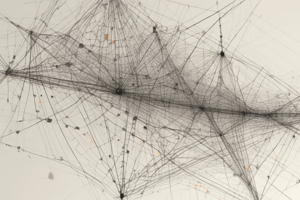Podcast
Questions and Answers
In graph theory, what are the mathematical abstractions called?
In graph theory, what are the mathematical abstractions called?
- Edges
- Lines
- Links
- Vertices (correct)
How are the edges in a graph typically depicted?
How are the edges in a graph typically depicted?
- As triangles or polygons
- As dots or circles
- As lines or curves (correct)
- As squares or rectangles
What does it mean if a graph is undirected?
What does it mean if a graph is undirected?
- There is an edge from person A to person B if A owes money to B
- The edges have a direction from one vertex to another
- The vertices have reciprocal relationships
- Any person A can shake hands with a person B only if B also shakes hands with A (correct)
What is the significance of a directed edge in a graph?
What is the significance of a directed edge in a graph?
Why was the word 'graph' first used in the context of graph theory?
Why was the word 'graph' first used in the context of graph theory?
What are vertices in a graph also known as?
What are vertices in a graph also known as?
What is a graph in the context of graph theory?
What is a graph in the context of graph theory?
How are edges used in a graph?
How are edges used in a graph?
Who introduced the concept of graph theory?
Who introduced the concept of graph theory?
Where can the application of linear graphs be used besides discrete mathematics?
Where can the application of linear graphs be used besides discrete mathematics?
Flashcards are hidden until you start studying
Study Notes
Graph Theory Basics
- In graph theory, mathematical abstractions are called graphs.
Graph Representation
- Edges in a graph are typically depicted as lines or arcs between vertices.
Undirected Graphs
- An undirected graph is a graph where the edges do not have direction, i.e., they do not have an arrowhead.
Directed Graphs
- A directed edge in a graph represents a one-way relationship between vertices, indicated by an arrowhead.
- The significance of a directed edge is that it implies a direction of flow or influence from one vertex to another.
Origins of Graph Theory
- The word 'graph' was first used in the context of graph theory by James Joseph Sylvester in 1878.
Vertices
- Vertices in a graph are also known as nodes or points.
Graph Definition
- A graph in the context of graph theory is a non-linear data structure consisting of vertices connected by edges.
Edge Functionality
- Edges are used in a graph to represent relationships between vertices, such as connections, interactions, or flows.
Graph Theory History
- The concept of graph theory was introduced by Leonhard Euler in the 18th century.
Applications of Linear Graphs
- Besides discrete mathematics, the application of linear graphs can be used in fields such as computer science, physics, biology, and social network analysis.
Studying That Suits You
Use AI to generate personalized quizzes and flashcards to suit your learning preferences.




